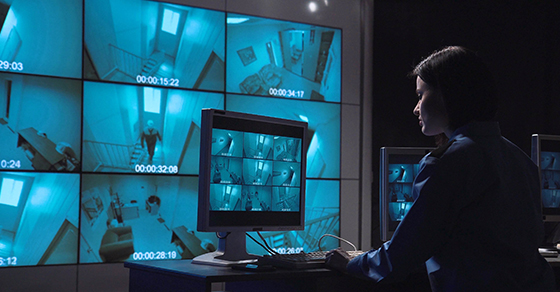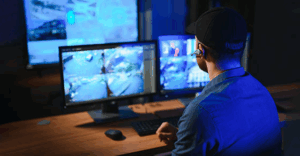Live video monitoring is a preventative, tech-based security application that identifies, verifies, and mitigates threats in real-time. It is a smarter way to protect people, property and assets, during the day or night, and in any conditions.
n this blog post, we will define live video monitoring, discuss how live video monitoring works, and talk about why live video monitoring for business and homeowners is a growing necessity and a trend that’s moving in only one direction.
What Is Live Video Monitoring
Live video monitoring involves using security cameras, analytics powered by artificial intelligence, and trained agents to actively monitor security camera feeds. Unlike static systems, which merely capture footage, this function will allow actual intervention – stopping crimes before they happen.
Agents can provide live monitoring, issuing voice warnings, setting sirens or strobe lights off and alerting the police in case of a verified threat. The end result – quicker response times, less false alarms, and significantly increased deterrence.
Live Video Monitoring is known by many terms. They include;
Core terms
- Live video monitoring
- Live video surveillance
- Real-time video monitoring
- Real-time remote video surveillance
- Active video monitoring
- Interactive video monitoring
- 24/7 video monitoring
- Camera monitoring service
- Live security camera monitoring
- Live CCTV monitoring
“Virtual guard” / guard replacement language
- Virtual guarding
- Virtual security guard
- Remote guarding
- Remote guard services
- Virtual patrols / remote video patrols
- Talk-down monitoring / audio talk-down deterrence
- Voice-down deterrence
Verification & response
- Video alarm verification
- Video-verified alarms
- Verified video monitoring
- Central station video monitoring
- Video-based intrusion detection
- Event-based (exception-based) video monitoring
Managed / cloud / SOC framing
- Managed video monitoring
- Managed video surveillance
- Hosted video monitoring
- Cloud video monitoring
- SOC-as-a-Service video monitoring
- Remote SOC video surveillance
AI / analytics-led
- AI video surveillance
- AI-powered video monitoring
- Video analytics monitoring
- Intelligent video monitoring
- Proactive video monitoring
Perimeter / site specific
- Remote perimeter monitoring
- Remote site monitoring
- Construction site video monitoring
- Parking lot video monitoring
- Yard/laydown yard video monitoring
Regional / legacy phrasing
- Remote CCTV monitoring
- Live CCTV surveillance
- Remote camera monitoring
How It Works
Live video monitoring operates through a layered, integrated system:
1. High-Definition Cameras
Outdoor and indoor IP cameras capture activity in real time. Features include night vision, motion detection, and wide-angle views.
2. AI Video Analytics
Smart software can detect people, vehicles or particular behaviors such as lingering or a breach of the perimeter.
3. Remote Monitoring Agents
When suspicious activity is detected, human operators instantly review the footage and take action.
4. Real-Time Intervention
Agents can speak directly to intruders via loudspeakers, set off sirens or strobe lights, and contact police if necessary.
5. Cloud Access and Notifications
Users can watch live or recorded footage, receive real time alerts, and control their systems using a mobile app or browser dashboard..
Why Businesses and Homeowners Choose Live Video Monitoring
Whether you operate a business or need to protect your home, live video monitoring provides the ultimate benefits:
Key Benefits
- Crime prevention—and, not after-the-fact.
- Prevents vandalism, damage, break-ins and trespassing due to its deterrent effect
- Watches high-traffic areas like driveways, loading docks, and parking lots
- Real threats are verified by professionally trained agents and false alarms decline
- Verified events trigger faster police response
- Eliminates the need for costly on-site security guards
- Protects multiple zones 24/7, even if the site is unmanned
- Aids in compliance with insurance for active surveillance
- Accessible from anywhere through secure apps
- Cloud storage (reviewed video stored in the cloud)
Use Cases by Industry
Live video monitoring fits a wide range of commercial and residential needs:
- Retail – Deter theft and protect stores after hours
- Construction Sites – To protect tools and materials on a job site while unattended
- Warehouses & Logistics – Keeps an eye on loading docks, gates and staff safety
- Multi-Family Properties – Protects common areas, entryways, and parking lots
- Schools & Campuses – Provides oversight in real time and aids emergency response
- Homes – Monitors driveways, backyards, and garages with proactive alerts
Live Monitoring vs Traditional Security
| Feature | Live Video Monitoring | Traditional CCTV / Guards |
|---|---|---|
| Response Time | Immediate | Delayed or after-the-fact |
| Deterrent Value | High – voice-downs & sirens | Low – passive recording |
| Human Involvement | Remote agents with escalation | On-site patrols or none |
| Coverage | 24/7, multi-angle, scalable | Limited to shift and scope |
| Cost | Lower than guards | Higher due to staffing needs |
| False Alarm Rate | Reduced via verification | Higher without visual review |
Common Questions
Is live video monitoring the same as a security system?
No. A typical security system consists of alarms and passive cameras. By adding live video monitoring, you introduce the ability for both real-time human intervention and AI analytics, making for a much more interactive and responsive solution.
Does it replace on-site guards?
In many cases, yes. Virtual guarding provides wider protection, 24-hour coverage, and immediate notifications—with no additional cost.
Will it work at night?
Yes. Nearly all systems have infrared and/ or low-light cameras so that clear footage can be captured even in total darkness.
Can I access it remotely?
Yes. You can get alerts, watch live feeds and control your system from mobile and desktop interfaces.
Why It Matters Now
The demand for proactive security is rising as threats become more complex and costly. Businesses are under pressure to secure multiple locations, reduce liability, and respond to incidents faster. Homeowners want peace of mind that traditional alarm systems can’t always provide.
Live video monitoring provides a scalable, adaptable and economical solution to these demands.
Implementation Steps
To set up live monitoring:
1. Assess Risks – Determine which are the points most susceptible to breaches or losses
2. Install Smart Cameras – Use HD cameras with coverage of entry points, perimeters, and sensitive zones
3. Define Monitoring Zones – Set rules for motion detection, restricted access, and virtual perimeters
4. Connect to Monitoring Agents – Link your system to trained operators who review and respond to alerts
5. Test and Optimize – Regularly test speaker warnings, strobe lights, and response time to ensure performance
6. Access Anytime – Download the app and log in via desktop for full control and video playback
Internal Resources
Want to see how VideoGuard can help? Explore our remote video monitoring solutions to compare features.
Learn how our proactive monitoring stops crime before it starts.
Final Thoughts
Live video monitoring is a powerful step forward in smart security. It combines intelligent technology with professional human intervention – offering stronger deterrent, faster response and better resolution than stand-alone alternatives.
Whether you’re protecting a business or your home, this is how you stay one step ahead.







